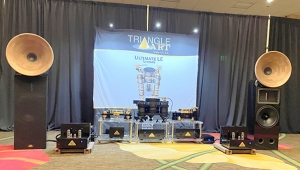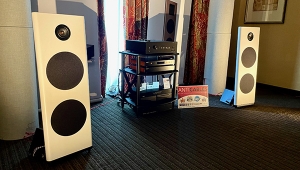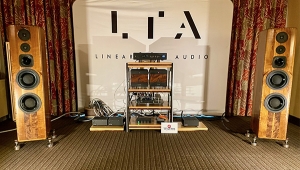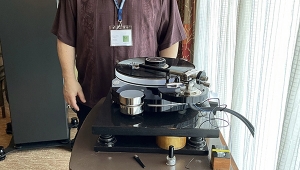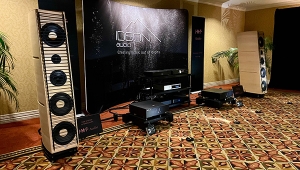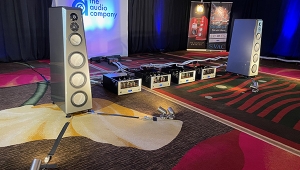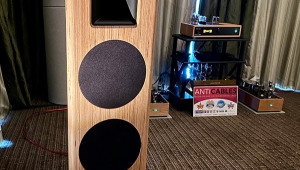| Columns Retired Columns & Blogs |
Magnetic Attraction to Klaudio's New Magnezar Turntable

One of the highlights of my visit to PAF 2023 was the debut of Klaudio's $80,000 Magnezar Turntable. The world of super-premium turntables is curiously large and active these days, and it's not that surprising to hear of another one hitting the market. From the first glance, though, it was obvious that Klaudio's Magnezar was something extraordinary. For starters it eschewed the "platter plus pods" structure that's become synonymous with super-premium turntables. Instead, it's a modern take on the traditional plinth, armboard, and platter configuration, giving it a chunky, more integrated look that somehow seemed more modern.
The centerpiece of the turntable, in form and function, is the 6" thick, 44lb platter assembly. As its name implies, the platter is magnetically levitated. An array of rare earth magnets sit below the platter and their interaction with its steel bottom section provides all of the vertical force. There is a bushing to locate the platter horizontally, but no thrust bearing. I could almost convince myself that it felt a little different to spin the Magnezar's platter. Almost.

The platter is a complex, multi-layer assembly, including one that provides liquid damping. Even that's not the coolest part of the platter though, which is the integrated, automatic clamping system. When the tonearm is at the home position (on its rest), a center pillar, slightly larger than the diameter of a record, extends about ½" above a stack of two surrounding toroidal sections. When the system is activated, the upper toroid rises until its top is about 1" above the record surface, the segments making up the perimeter clamp move inward to form a continuous ring, and the toroid lowers, locking the record in place, and a circumferential light comes on to indicate the process is complete.
A large chassis running front to back to the right of the platter is the armboard assembly. In addition to providing a mount for a tonearm, the assembly adds fully automatic functionality and incorporates a laser assembly that projects a line across the record. In addition to looking really cool, the laser projects a path for the stylus that eliminates tracking error as long as the cantilever remains perpendicular to the line. This can't happen with a traditional pivoting tonearm, but it can with Klaudio's Tangential Tonearm. This arm, achingly beautiful in its complexity, looks, and to some extent acts, like a traditional pivoting tonearm, but functions very differently. The arm "tube" consists of two parallel carbon-fiber beams that move independently to change their effective lengths, thus changing the offset angle between the headshell and arm tube. This, combined with an accompanying movement of the arm's pivot point itself, keep the cartridge aligned properly as the stylus follows the line across the record. The laser makes cartridge alignments a snap as well. A small knob is turned to move the cartridge fore and aft until the stylus breaks the laser and you're done.

It was hard to pull myself away from the turntable to sit and listen to the system but when I did, it was definitely worth the trouble. In addition to the Magnezar and Tangential Tonearm, the system comprised a Klaudio moving coil step-up transformer and prototype line stage, Pass Labs 600.8 monoblock amplifiers, and Wilson Audio Alexia V loudspeakers. Everything that Peter Cheon (shown above with his record cleaning machine) queued up, from a lovely solo cello to full orchestral was rendered beautifully, and with a beguiling combination of ease, transparency, and precision I associate with linear tracking tonearms.
- Log in or register to post comments



